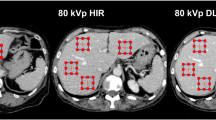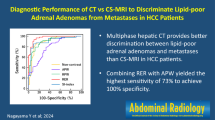Abstract
Objective
To evaluate image quality and diagnostic confidence improvement using a thin slice and a deep learning image reconstruction (DLIR) in contrast-enhanced abdominal CT.
Methods
Forty patients with hepatic lesions in enhanced abdominal CT were retrospectively analyzed. Images in the portal phase were reconstructed at 5 mm and 1.25 mm slice thickness using the 50% adaptive statistical iterative reconstruction (ASIR-V) (ASIR-V50%) and at 1.25 mm using DLIR at medium (DLIR-M) and high (DLIR-H) settings. CT number and standard deviation of the hepatic parenchyma, spleen, portal vein, and subcutaneous fat were measured, and contrast-to-noise ratio (CNR) was calculated. Edge-rise-slope (ERS) was measured on the portal vein to reflect spatial resolution and the CT number skewness on liver parenchyma was calculated to reflect image texture. Two radiologists blindly assessed the overall image quality including subjective noise, image contrast, visibility of small structures using a 5-point scale, and object sharpness and lesion contour using a 4-point scale.
Results
For the 1.25-mm images, DLIR significantly reduced image noise, improved CNR and overall subjective image quality compared to ASIR-V50%. Compared to the 5-mm ASIR-V50% images, DLIR images had significantly higher scores in the visibility and contour for small structures and lesions; as well as significantly higher ERS and lower CT number skewness. At a quarter of the signal strength, the 1.25-mm DLIR-H images had a similar subjective noise score as the 5-mm ASIR-V50% images.
Conclusion
DLIR significantly reduces image noise and maintains a more natural image texture; image spatial resolution and diagnostic confidence can be improved using thin slice images and DLIR in abdominal CT.
Key Points
• DLIR further reduces image noise compared with ASIR-V while maintaining favorable image texture.
• In abdominal CT, thinner slice images improve image spatial resolution and small object visualization but suffer from higher image noise.
• Thinner slice images combined with DLIR in abdominal CT significantly suppress image noise for detecting low-density lesions while significantly improving image spatial resolution and overall image quality.





Similar content being viewed by others
Abbreviations
- AP :
-
Arterial-phase
- ASIR-V :
-
Adaptive statistical iterative reconstruction-V
- ASIR-V 50%:
-
ASIR-V with blending factors of 50%
- CNR:
-
Contrast-to-noise ratio
- DLIR:
-
Deep learning image reconstruction
- DLIR-H:
-
DLIR with high settings
- DLIR-M:
-
DLIR with medium settings
- DNN:
-
Deep neural networks
- ERS:
-
Edge-rise-slope
- FBP:
-
Filtered back projection
- IR:
-
Iterative reconstruction
- NI:
-
Noise index
- PP:
-
Portal-phase
- ROI:
-
Regions-of-interest
- SD:
-
Standard deviation
References
Smith JT, Hawkins RM, Guthrie JA et al (2010) Effect of slice thickness on liver lesion detection and characterisation by multidetector CT. J Med Imaging Radiat Oncol 54:188–193
Masoom AH, Marianne MA, Rappaport DC et al (2002) Multi-detector row helical CT in preoperative assessment of small (<1.5 cm) liver metastases: is thinner collimation better? Radiology 225(1):137–142
Parakh A, Cao J, Pierce TT, Blake MA, Savage CA, Kambadakone AR (2021) Sinogram-based deep learning image reconstruction technique in abdominal CT: image quality considerations. Eur Radiol 31:8342–8353
Nam JG, Ahn C, Choi H et al (2021) Image quality of ultralow-dose chest CT using deep learning techniques: potential superiority of vendor-agnostic post-processing over vendor-specific techniques. Eur Radiol 31:5139–5147
Kim JH, Yoon HJ, Lee E, Kim I, Cha YK, Bak SH (2021) Validation of deep-learning image reconstruction for low-dose chest computed tomography scan: emphasis on image quality and noise. Korean J Radiol 22:131–138
Nam JG, Hong JH, Kim DS, Oh J, Goo JM (2021) Deep learning reconstruction for contrast-enhanced CT of the upper abdomen: similar image quality with lower radiation dose in direct comparison with iterative reconstruction. Eur Radiol 31:5533–5543
Noda Y, Iritani Y, Kawai N et al (2021) Deep learning image reconstruction for pancreatic low-dose computed tomography: comparison with hybrid iterative reconstruction. Abdom Radiol (NY) 46:4238–4244
Ichikawa Y, Kanii Y, Yamazaki A et al (2021) Deep learning image reconstruction for improvement of image quality of abdominal computed tomography: comparison with hybrid iterative reconstruction. Jpn J Radiol 39:598–604
Kaga T, Noda Y, Fujimoto K et al (2021) Deep-learning-based image reconstruction in dynamic contrast-enhanced abdominal CT: image quality and lesion detection among reconstruction strength levels. Clin Radiol 76:710 e715–710 e724
Jensen CT, Liu X, Tamm EP et al (2020) Image quality assessment of abdominal CT by use of new deep learning image reconstruction: initial experience. AJR Am J Roentgenol 215:50–57
Ge H (2019) A new era of image reconstruction: Truefidelity™ technical white paper on deep learning image reconstruction. Available from: https://www.gehealthcare.com/-/jssmedia/040dd213fa89463287155151fdb01922.pdf
Marin D, Nelson RC, Schindera ST et al (2010) Low-tube-voltage, high-tube-current multidetector abdominal CT: improved image quality and decreased radiation dose with adaptive statistical iterative reconstruction algorithm--initial clinical experience. Radiology 254:145–153
Suzuki S, Machida H, Tanaka I, Ueno E (2013) Vascular diameter measurement in CT angiography: comparison of model-based iterative reconstruction and standard filtered back projection algorithms in vitro. AJR Am J Roentgenol 200:652–657
Tatsugami F, Higaki T, Nakamura Y et al (2019) Deep learning-based image restoration algorithm for coronary CT angiography. Eur Radiol 29:5322–5329
Abadi E, Sanders J, Samei E (2017) Patient-specific quantification of image quality: an automated technique for measuring the distribution of organ Hounsfield units in clinical chest CT images. Med Phys 44:4736–4746
Verdun FR, Racine D, Ott JG et al (2015) Image quality in CT: from physical measurements to model observers. Phys Med 31:823–843
Samei E, Richard S (2015) Assessment of the dose reduction potential of a model-based iterative reconstruction algorithm using a task-based performance metrology. Med Phys 42:314–323
Brady SL, Trout AT, Somasundaram E, Anton CG, Li Y, Dillman JR (2021) Improving image quality and reducing radiation dose for pediatric CT by using deep learning reconstruction. Radiology 298:180–188
Wang X, Zheng F, Xiao R et al (2021) Comparison of image quality and lesion diagnosis in abdominopelvic unenhanced CT between reduced-dose CT using deep learning post-processing and standard-dose CT using iterative reconstruction: a prospective study. Eur J Radiol 139:109735
Hong JH, Park EA, Lee W, Ahn C, Kim JH (2020) Incremental image noise reduction in coronary CT angiography using a deep learning-based technique with iterative reconstruction. Korean J Radiol 21:1165–1177
Liu P, Wang M, Wang Y et al (2020) Impact of deep learning-based optimization algorithm on image quality of low-dose coronary CT angiography with noise reduction: a prospective study. Acad Radiol 27:1241–1248
Tian SF, Liu AL, Liu JH, Liu YJ, Pan JD (2019) Potential value of the PixelShine deep learning algorithm for increasing quality of 70 kVp+ASiR-V reconstruction pelvic arterial phase CT images. Jpn J Radiol 37:186–190
Oostveen LJ, Meijer FJA, de Lange F et al (2021) Deep learning-based reconstruction may improve non-contrast cerebral CT imaging compared to other current reconstruction algorithms. Eur Radiol 31:5498–5506
Cao L, Liu X, Li J et al (2021) A study of using a deep learning image reconstruction to improve the image quality of extremely low-dose contrast-enhanced abdominal CT for patients with hepatic lesions. Br J Radiol 94:20201086
Funding
This study was supported by the Science Development Foundation of the First Affiliated Hospital of Xi’an Jiaotong University (2018QN-14), Key R & D Plan Project of Shaanxi Province - Joint University Project (NO. 2020GXLH-Y-026), 3D Printing Medical Research Support Project of the First Affiliated Hospital of Xi’an Jiaotong University (NO. XJTU1AF-3D-2018-003).
Author information
Authors and Affiliations
Corresponding author
Ethics declarations
Guarantor
The scientific guarantor of this publication is Prof. Jianxin Guo from the Department of Radiology, The First Affiliated Hospital of Xi’an Jiaotong University.
Conflict of interest
One author (J.L.) is an employee of GE Healthcare, the manufacturer of the CT scanner and the reconstruction algorithms used in this study. All other authors of this manuscript declare no conflict of Interest with any companies, whose products or services may be related to the subject matter of the article. Authors who are not GE Healthcare employees had total control of the data and analysis used in the study.
Statistics and biometry
No complex statistical methods were necessary for this paper.
Informed consent
Informed written consent was obtained from all the patients for undergoing the routine contrast-enhanced abdominal CT scans and for using their CT images in general, but informed consent for this specific retrospective study was waived.
Ethical approval
Institutional Review Board approval was obtained.
Methodology
• retrospective
• cohort study
• performed at one institution
Additional information
Publisher’s note
Springer Nature remains neutral with regard to jurisdictional claims in published maps and institutional affiliations.
Rights and permissions
Springer Nature or its licensor holds exclusive rights to this article under a publishing agreement with the author(s) or other rightsholder(s); author self-archiving of the accepted manuscript version of this article is solely governed by the terms of such publishing agreement and applicable law.
About this article
Cite this article
Cao, L., Liu, X., Qu, T. et al. Improving spatial resolution and diagnostic confidence with thinner slice and deep learning image reconstruction in contrast-enhanced abdominal CT. Eur Radiol 33, 1603–1611 (2023). https://doi.org/10.1007/s00330-022-09146-y
Received:
Revised:
Accepted:
Published:
Issue Date:
DOI: https://doi.org/10.1007/s00330-022-09146-y




